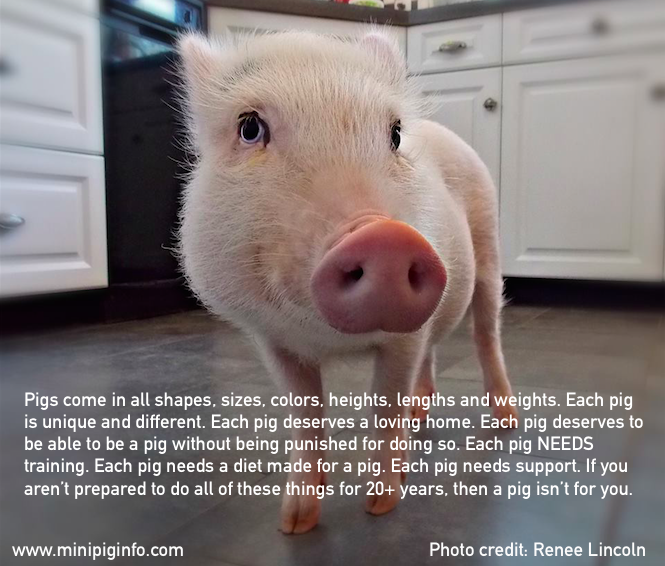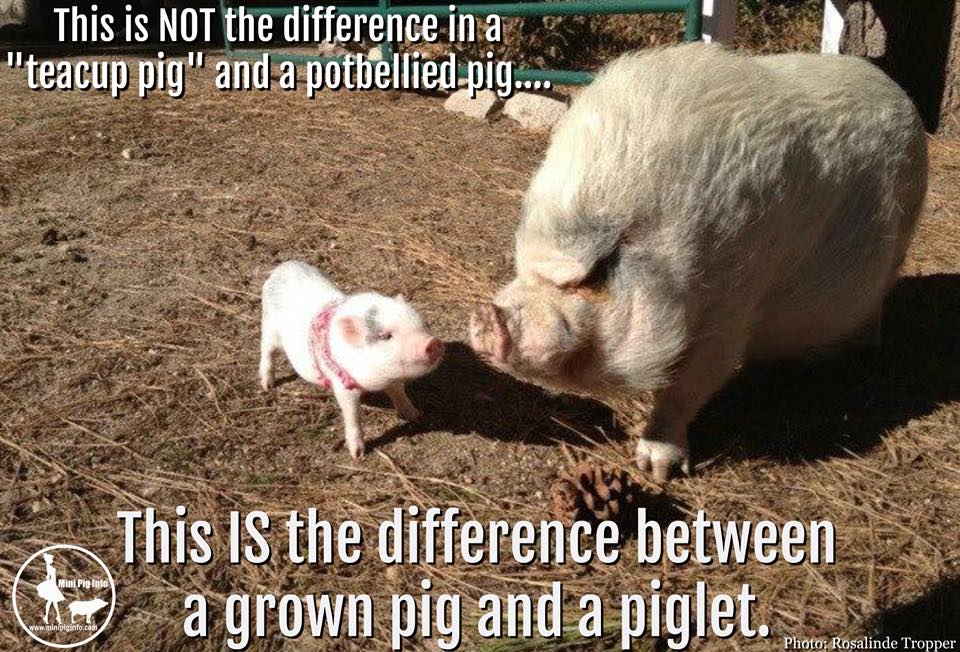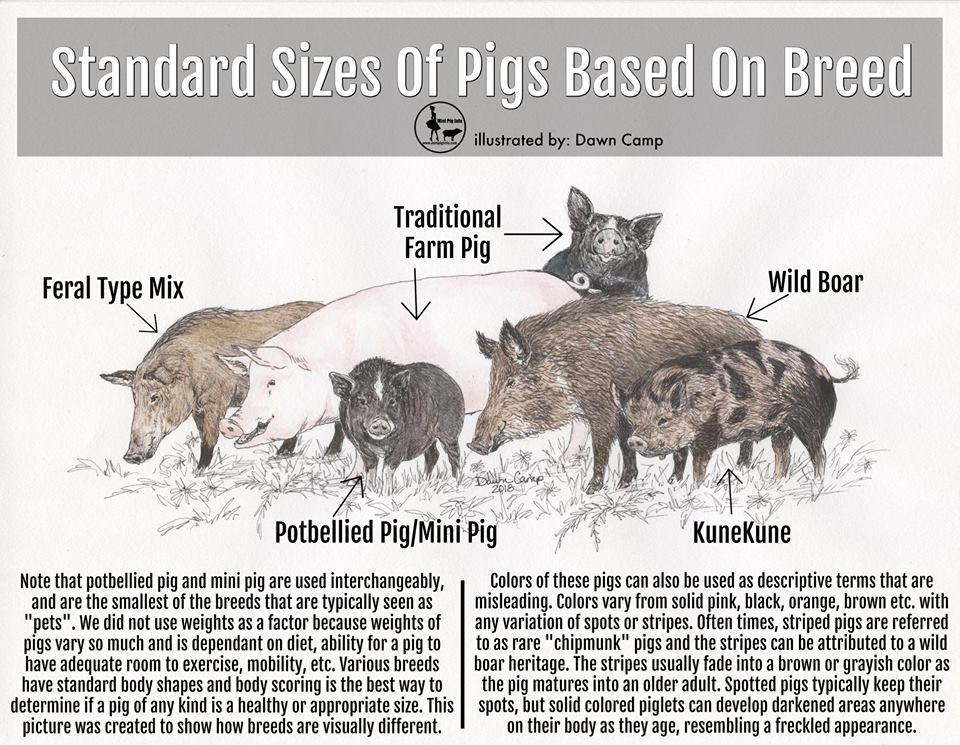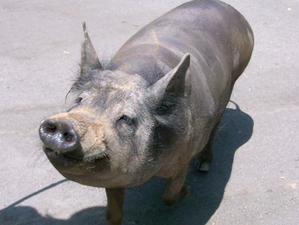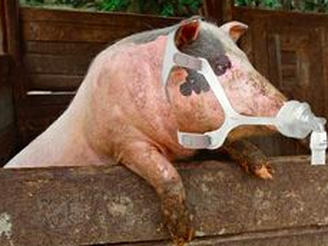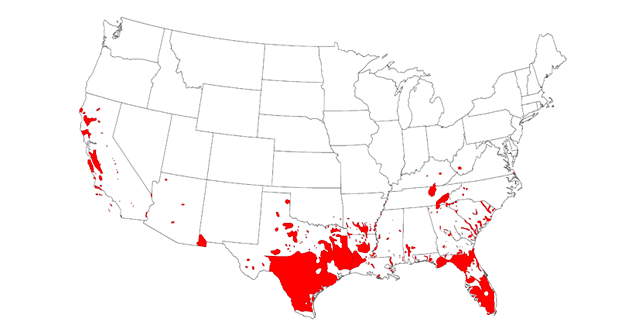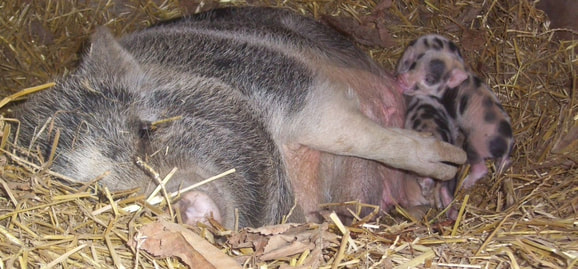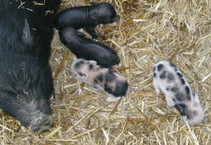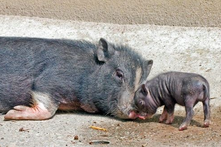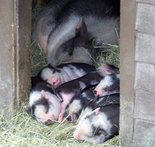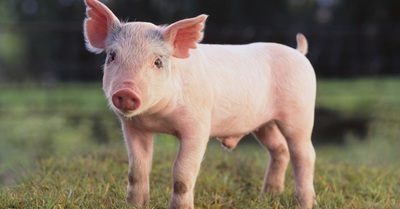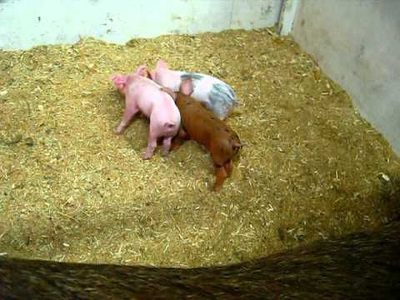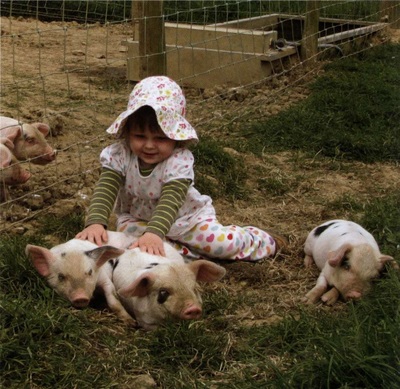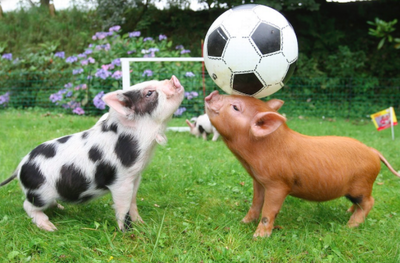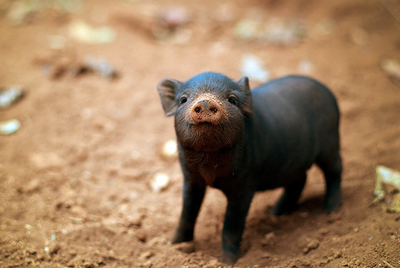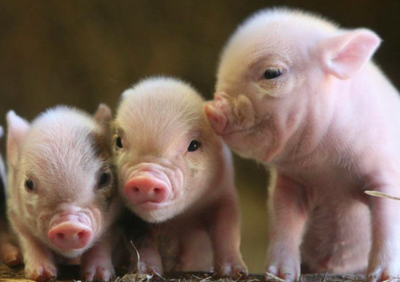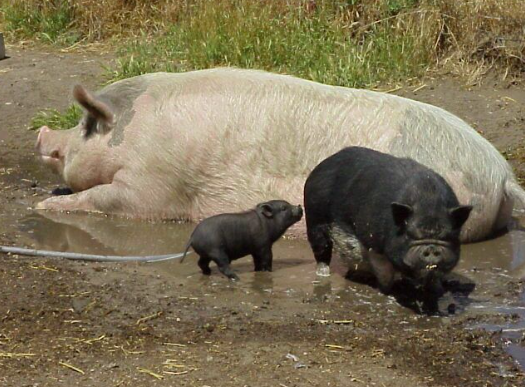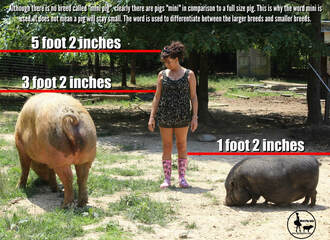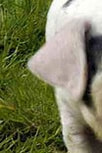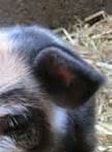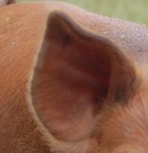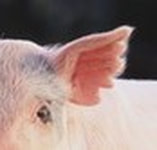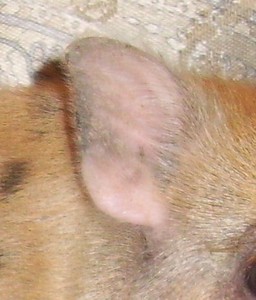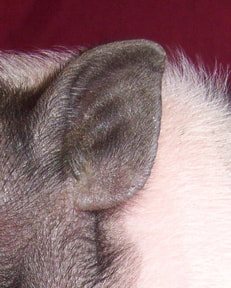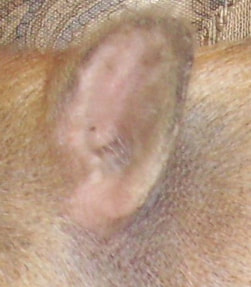Real Breeds Of Miniature Pigs
Nano/Pixie/Teacup/Micro/Micro-Mini/Pocket/Dandy/Designer Pig MYTH
First off, I would like to address the term "mini pig" and its' use in referencing the types of pigs you typically see as pets. There is no such a thing as a "Teacup, Micro, Nano, Dandie, Pocket, Apartment or Pixie" pig. These are all marketing terms. There is no breed called "mini", but that has become a widely used and accepted term used to identify a class of pigs, not an actual breed. There is such a thing as a piglet, which is likely what you see when you see these terms. Do NOT be fooled by a fancy name referring to a non-existent breed of pigs. There are smaller pigs out there, however, no one can guarantee the height or weight of a pig when it reaches maturity, and smaller pigs are the exception, not the rule. Those terms are used to "entice" people into buying a piglet and some even go as far as to tell the potential pig parents they have several generations of pigs and none are over 20 pounds, etc. These are lies. Period. People will even come up with their own breed and market that such as "dandie", "nano extreme" or "micro mini pocket" pigs. Again, those are only terms or words someone will use to paint an unrealistic picture of what you will actually be getting, Mini is used to describe a pig smaller than a farm pig, so even mini is a bit misleading because a mini pig can still grow to be 300 lbs and still considered in that class of pigs. Full grown pigs, meaning pigs that are older than 5 years old, (or usually even pigs that are 6 months old or older) will not fit into a teacup, so these terms have been used to market piglets for sale and not only are the terms deceitful, but obviously unrealistic and often set new piggy parents up for major disappointment. Scientists haven't been able to genetically alter a healthy pig under 60 pounds, why would you think a layman with no scientific degree could do any better? The keyword here is HEALTHY. Have breeders sold a pig that stayed under 60 pounds? Of course they have, but they cannot consistently produce pigs that stay this size regardless of what breeding practices they're using to use selective breeding to "breed them down to a smaller size". A promise isn't what keeps a pig small, genetic defects and/or starvation does. There are a few exceptions, there are pigs out there that are of a smaller stature, but these pigs are highly debated and because I haven't seen them personally nor do I know their history, I will not comment with an opinion. Just be sure to know this is NOT the typical scenario and pigs grow. 99.999999% of them will grow much bigger than these super small pigs that you may be expecting to get. Most pigs will top off around the 70-150 pound mark. Not all, but most. Size isn't what should matter, if you want a healthy pig, quit worrying about how big your pig may get and focus on keeping your pig healthy. Pigs aren't judged by their weight, they are judged or deemed to be healthy/unhealthy by their body score. Body scores are a more appropriate way to gauge whether or not a pig is at a healthy size/shape. You can click here to learn more about what healthy versus unhealthy pigs look like. We have also built a page on our website with real pigs, real families and their pigs. Some were also promised a much smaller pig than they actually got, this is the reason we try to inform others of the teacup/micro pig myth BEFORE they get a pig and figure it out the hard way, sometimes even being forced to find another home for their pig due to size restrictions in an uneducated city ordinance. Click here to see realistic pigs and their sizes.
Anyone can tell you that the parent pigs are fully grown and when you see them, they may be smaller pigs. That may be the case, but pigs grow until they're 3-5 years old and people are breeding young pigs claiming that they're fully grown and have reached maturity, unfortunately, that's not always the case. Sometimes people will flat out lie and they know they're breeding babies, so please don't be fooled. If you insist on buying a piglet, please be sure the piglet has the time it needs with its' mother. Not only is this time important for health reasons, like acquiring the immunity they need by drinking mothers milk, but they also learn manners and respect while being raised with their mama and siblings. Bottle fed babies are at a high risk for aspiration and it's extremely dangerous to do this, even for those with experience. A pig needs to stay with its mother until they're at the very least 8 weeks old, if you get a piglet younger than that, you're setting yourself up for failure/heartache. Please do NOT get a few day old piglet!!!!!!! (Click here to visit the underage piglet page) Genetics are what drives the growth of pigs, not a promise from someone selling them. Not giving adequate feed can stunt the growth because they rely on the nutrition to build healthy bones, healthy organs, strong immunity and overall normal bodily function. Ask any pig rescue who has any of these "designer" pigs about the overall size and disposition. They have no reason to be dishonest. Some rescues actually have some of these pigs that people literally paid THOUSANDS for. Pigs are handed over to rescues for many reasons, but the number 1 reason I've heard is the pig grew too big. Starving your pig to keep it small is not only cruel, but in my opinion, abuse, and your pig can die from malnutrition. Overfeeding your pig has its' own health risks and can lead to your pig living a sad, poor quality filled life in addition to the possibility of being fat blind and arthritic with limited mobility amongst other health complications. (Click here to see our blog regarding underfed pigs)
Some people will believe what they hear because that's what they want to believe and nothing I say, or the hundred's of other pig parent's words, advice or evidence will change their minds. Unfortunately, these are likely the same pigs everyone will be networking to find a new home for in a few months because they're no longer wanted once the cuteness wears off. Some people just can't handle it, they weren't prepared for a pig, they don't understand pigs and honestly, had no business getting one to begin with. I've been quoted statistics as high as 90% of pigs are re-homed before their 1st birthday. That is a super high percentage, but based on what I see daily, I would have to agree that the number is high, maybe not quite that high, but it's not 15%, it is absolutely a high percentage. (We are currently doing a poll to try and capture a good cross-section of pig parents to try and obtain more accurate numbers based on real data, you can participate in that poll by clicking here.) The pig rescues are full and overflowing with unwanted pigs. Some people have city guidelines they must follow to be in compliance and can't take anymore pigs, some people aren't even zoned for the one they do have, and there is nowhere else to send all these unwanted pigs!!!! Some people, who no longer want the responsibility, are even asking for a large "rehoming" fee that is close to what they paid for the pig. You can barely GIVE pigs away nowadays, so if you decide to get one, and you no longer want it, be prepared to learn an expensive life lesson when you get little to no money during your attempts to find a new home for your pig. Pigs being given away on Craigslist and other pet finder websites often fall into the hands of people who do NOT want them as pets. Pigs have been known to be used for dog bait for illegal dog fighting arenas, some of these "pet" pigs that were unwanted have even been used for food. People who don't care about pigs like we do in the pig community do not view them as "pets", they see a holiday BBQ. That's scary. I cannot imagine how these pigs feel going from the life of luxury with a nice indoor/outdoor space to the back of someone's pickup truck and quickly finding themselves in a dirty backyard with someone chasing them around with a knife. It's HORRIFYING to think about.
Adding a pig to your family is a life altering commitment. They're not like regular animals, they need people and socialization. They have the mindset to live in a herd and you and your family are their herd. They need interaction, stimulation and to feel safe and secure. If you're not prepared to provide this for the next 15 years, then honestly, you should really reconsider getting a pig until you know you can provide these things. Sometimes you will hear people referring to breeds that are used for medical research, NO pig that has been used for biomedical research will ever be sold to the public. This would be a health risk and also compromise years of data collected during the testing. It would also open the door for a competitor to gain valuable information about whatever product, methodology or medication was being tested, therefore, research animals are destroyed after they're no longer needed or required for whatever study they are involved in. Occasionally lab pigs have been granted a 2nd chance and been released to a pig rescue, but there are contracts and secrecy involved with that meaning the rescue isn't allowed to discuss the circumstances surrounding the testing/lab, etc. Because people are horrified when they see pictures of these lab pigs once they get to an animal sanctuary, and these stories go viral, it's becoming less and less frequent that pigs are allowed to live out the rest of their lives at sanctuaries. (Just wanted to clarify for those who have asked about research pigs) Let me elaborate by saying, pigs that have been used in biomedical research are used because their organ systems closely resemble that of a human. To truly understand how medications or products or (just throwing out some examples) mesh sling systems or IVC filters truly function along with their long term effects, they usually euthanize these animals to dissect the tissue and organs so their research is complete. THESE animals are not sold afterwards, because they are killed to study tissue samples or test or assess the various organs for signs of failure/damage. The laboratories get these pigs from breeders, so is it possible that one of these breeders violated the code of ethics and sold one to another breeder? That is possible, yes. Maybe they even have a clause where they're able to, but it's not literally the pig that they used for biomedical research trials, that would be the same family of pigs, but not one they've done any testing on. Research is done for may different things. If the researchers were testing how a pig grows on different feed, those pigs are likely not a threat, and most likely would not need to dissect tissue and/or organs to do their study, so in that type of non-biomedical research, those pigs could possibly be adopted out or find comfort at a pig rescue/sanctuary afterwards. We do know of a a couple of animal sanctuaries/rescues that houses research animals and may adopt them out. We do NOT know the type of research that was conducted on these animals though. Animals that may pose a threat to their intellectual data or to the public in general will NOT be sold or adopted out. Here is one the sanctuaries that does have research animals. http://kindnessranch.org/meet-the-animals/meet-our-pigs.
My advice is to research everything you can before you bring a pig into your home. Don't have unrealistic expectations of size or demeanor. If you've seen people post pictures of their pig and they're cuddling, don't expect your pig to do this. If this is normal for the pig that you saw, it's very likely that the bond between the human and pig took a long time to form and isn't something people achieve overnight. As a pig mother myself, I am also guilty of glamorizing having a pig as a pet. It may have taken me 1240 tries to capture a picture I felt was "internet worthy", but everyone doesn't know that. We usually only post the good pictures and not all the photos where our pig has knocked over the trash can, ate part of the wall or flooring or any unflattering picture of yourself even though it may have painted a completely different picture rather than the appearance represented by the one good/flattering picture you did post on Facebook or Instagram or some other social media platform.
Keep this in mind. Weight contracts are not enforceable. Surpassing the "guaranteed weight" can be blamed on diet rather than genetics. Any reputable person will not guarantee weight. It can't be done, no more than a parent can guarantee what their newborn baby will weigh as an adult. Weight guarantees are a unscrupulous sales practice used by "greeders". Most will offer to replace the pig and they know the family is not likely to give up their pig to start over and try to get a smaller version. People/families fall in love with their pigs and can't simply trade them out for another. This is what they are banking on, the fact that you will not want to give up a pet you've had in your home for a number of months or years for a "smaller" version. So essentially, their tactics have worked, they sold a pig, you got a pig and although the weight prediction was misleading/unethical/unrealistic, they will continue to lie and deceive people because, just like you, people do not want a new pig, they would like the non-existent micro version that never grows. NEWS FLASH...they all grow.
Consumer Affairs
http://www.consumeraffairs.com/research-before-buying-a-teacup-pig-or-mini-potbellied-pig-
Facts and myths about potbelly pigs video by Susan, President at Ross Mills Farms
http://www.howcast.com/videos/516053-myth-of-mini-pigs-micro-pigs-pet-pigs/
Susan from Ross Mill Farms article
http://alainamabaso.com/earth-to-the-internets-there-is-no-such-thing-as-a-teacup-pig/
News story regarding "mini pig: sizes
http://www.delawareonline.com/story/minipetpigs-dontmeantheystaysmall
The inside edition report on "mini pigs" that I recorded on my DVR and uploaded to YouTube regarding the truth about mini pigs.
https://youtube/insideedition-minipigs
Vegas Pig Pets article on size lies
https://www.thedodo.com/teacup-pig-pet
The big problem with Mini pigs National Geographic article
http://news.nationalgeographic.com/news/animals-culture-science-miniature-pigs-breeders-sanctuaries/
Another article highlighting that pigs don't stay small
http://www.southernfriedscience.com/pigsdontstaysmall
We are not the only website that highlights the facts that teacup pigs do NOT exist.
http://www.teacuppig.info
Newest story about rescues being overwhelmed with "teacup" pigs
http://www.fox13news.com/news/local-news/98070718-story
Anyone can tell you that the parent pigs are fully grown and when you see them, they may be smaller pigs. That may be the case, but pigs grow until they're 3-5 years old and people are breeding young pigs claiming that they're fully grown and have reached maturity, unfortunately, that's not always the case. Sometimes people will flat out lie and they know they're breeding babies, so please don't be fooled. If you insist on buying a piglet, please be sure the piglet has the time it needs with its' mother. Not only is this time important for health reasons, like acquiring the immunity they need by drinking mothers milk, but they also learn manners and respect while being raised with their mama and siblings. Bottle fed babies are at a high risk for aspiration and it's extremely dangerous to do this, even for those with experience. A pig needs to stay with its mother until they're at the very least 8 weeks old, if you get a piglet younger than that, you're setting yourself up for failure/heartache. Please do NOT get a few day old piglet!!!!!!! (Click here to visit the underage piglet page) Genetics are what drives the growth of pigs, not a promise from someone selling them. Not giving adequate feed can stunt the growth because they rely on the nutrition to build healthy bones, healthy organs, strong immunity and overall normal bodily function. Ask any pig rescue who has any of these "designer" pigs about the overall size and disposition. They have no reason to be dishonest. Some rescues actually have some of these pigs that people literally paid THOUSANDS for. Pigs are handed over to rescues for many reasons, but the number 1 reason I've heard is the pig grew too big. Starving your pig to keep it small is not only cruel, but in my opinion, abuse, and your pig can die from malnutrition. Overfeeding your pig has its' own health risks and can lead to your pig living a sad, poor quality filled life in addition to the possibility of being fat blind and arthritic with limited mobility amongst other health complications. (Click here to see our blog regarding underfed pigs)
Some people will believe what they hear because that's what they want to believe and nothing I say, or the hundred's of other pig parent's words, advice or evidence will change their minds. Unfortunately, these are likely the same pigs everyone will be networking to find a new home for in a few months because they're no longer wanted once the cuteness wears off. Some people just can't handle it, they weren't prepared for a pig, they don't understand pigs and honestly, had no business getting one to begin with. I've been quoted statistics as high as 90% of pigs are re-homed before their 1st birthday. That is a super high percentage, but based on what I see daily, I would have to agree that the number is high, maybe not quite that high, but it's not 15%, it is absolutely a high percentage. (We are currently doing a poll to try and capture a good cross-section of pig parents to try and obtain more accurate numbers based on real data, you can participate in that poll by clicking here.) The pig rescues are full and overflowing with unwanted pigs. Some people have city guidelines they must follow to be in compliance and can't take anymore pigs, some people aren't even zoned for the one they do have, and there is nowhere else to send all these unwanted pigs!!!! Some people, who no longer want the responsibility, are even asking for a large "rehoming" fee that is close to what they paid for the pig. You can barely GIVE pigs away nowadays, so if you decide to get one, and you no longer want it, be prepared to learn an expensive life lesson when you get little to no money during your attempts to find a new home for your pig. Pigs being given away on Craigslist and other pet finder websites often fall into the hands of people who do NOT want them as pets. Pigs have been known to be used for dog bait for illegal dog fighting arenas, some of these "pet" pigs that were unwanted have even been used for food. People who don't care about pigs like we do in the pig community do not view them as "pets", they see a holiday BBQ. That's scary. I cannot imagine how these pigs feel going from the life of luxury with a nice indoor/outdoor space to the back of someone's pickup truck and quickly finding themselves in a dirty backyard with someone chasing them around with a knife. It's HORRIFYING to think about.
Adding a pig to your family is a life altering commitment. They're not like regular animals, they need people and socialization. They have the mindset to live in a herd and you and your family are their herd. They need interaction, stimulation and to feel safe and secure. If you're not prepared to provide this for the next 15 years, then honestly, you should really reconsider getting a pig until you know you can provide these things. Sometimes you will hear people referring to breeds that are used for medical research, NO pig that has been used for biomedical research will ever be sold to the public. This would be a health risk and also compromise years of data collected during the testing. It would also open the door for a competitor to gain valuable information about whatever product, methodology or medication was being tested, therefore, research animals are destroyed after they're no longer needed or required for whatever study they are involved in. Occasionally lab pigs have been granted a 2nd chance and been released to a pig rescue, but there are contracts and secrecy involved with that meaning the rescue isn't allowed to discuss the circumstances surrounding the testing/lab, etc. Because people are horrified when they see pictures of these lab pigs once they get to an animal sanctuary, and these stories go viral, it's becoming less and less frequent that pigs are allowed to live out the rest of their lives at sanctuaries. (Just wanted to clarify for those who have asked about research pigs) Let me elaborate by saying, pigs that have been used in biomedical research are used because their organ systems closely resemble that of a human. To truly understand how medications or products or (just throwing out some examples) mesh sling systems or IVC filters truly function along with their long term effects, they usually euthanize these animals to dissect the tissue and organs so their research is complete. THESE animals are not sold afterwards, because they are killed to study tissue samples or test or assess the various organs for signs of failure/damage. The laboratories get these pigs from breeders, so is it possible that one of these breeders violated the code of ethics and sold one to another breeder? That is possible, yes. Maybe they even have a clause where they're able to, but it's not literally the pig that they used for biomedical research trials, that would be the same family of pigs, but not one they've done any testing on. Research is done for may different things. If the researchers were testing how a pig grows on different feed, those pigs are likely not a threat, and most likely would not need to dissect tissue and/or organs to do their study, so in that type of non-biomedical research, those pigs could possibly be adopted out or find comfort at a pig rescue/sanctuary afterwards. We do know of a a couple of animal sanctuaries/rescues that houses research animals and may adopt them out. We do NOT know the type of research that was conducted on these animals though. Animals that may pose a threat to their intellectual data or to the public in general will NOT be sold or adopted out. Here is one the sanctuaries that does have research animals. http://kindnessranch.org/meet-the-animals/meet-our-pigs.
My advice is to research everything you can before you bring a pig into your home. Don't have unrealistic expectations of size or demeanor. If you've seen people post pictures of their pig and they're cuddling, don't expect your pig to do this. If this is normal for the pig that you saw, it's very likely that the bond between the human and pig took a long time to form and isn't something people achieve overnight. As a pig mother myself, I am also guilty of glamorizing having a pig as a pet. It may have taken me 1240 tries to capture a picture I felt was "internet worthy", but everyone doesn't know that. We usually only post the good pictures and not all the photos where our pig has knocked over the trash can, ate part of the wall or flooring or any unflattering picture of yourself even though it may have painted a completely different picture rather than the appearance represented by the one good/flattering picture you did post on Facebook or Instagram or some other social media platform.
Keep this in mind. Weight contracts are not enforceable. Surpassing the "guaranteed weight" can be blamed on diet rather than genetics. Any reputable person will not guarantee weight. It can't be done, no more than a parent can guarantee what their newborn baby will weigh as an adult. Weight guarantees are a unscrupulous sales practice used by "greeders". Most will offer to replace the pig and they know the family is not likely to give up their pig to start over and try to get a smaller version. People/families fall in love with their pigs and can't simply trade them out for another. This is what they are banking on, the fact that you will not want to give up a pet you've had in your home for a number of months or years for a "smaller" version. So essentially, their tactics have worked, they sold a pig, you got a pig and although the weight prediction was misleading/unethical/unrealistic, they will continue to lie and deceive people because, just like you, people do not want a new pig, they would like the non-existent micro version that never grows. NEWS FLASH...they all grow.
Consumer Affairs
http://www.consumeraffairs.com/research-before-buying-a-teacup-pig-or-mini-potbellied-pig-
Facts and myths about potbelly pigs video by Susan, President at Ross Mills Farms
http://www.howcast.com/videos/516053-myth-of-mini-pigs-micro-pigs-pet-pigs/
Susan from Ross Mill Farms article
http://alainamabaso.com/earth-to-the-internets-there-is-no-such-thing-as-a-teacup-pig/
News story regarding "mini pig: sizes
http://www.delawareonline.com/story/minipetpigs-dontmeantheystaysmall
The inside edition report on "mini pigs" that I recorded on my DVR and uploaded to YouTube regarding the truth about mini pigs.
https://youtube/insideedition-minipigs
Vegas Pig Pets article on size lies
https://www.thedodo.com/teacup-pig-pet
The big problem with Mini pigs National Geographic article
http://news.nationalgeographic.com/news/animals-culture-science-miniature-pigs-breeders-sanctuaries/
Another article highlighting that pigs don't stay small
http://www.southernfriedscience.com/pigsdontstaysmall
We are not the only website that highlights the facts that teacup pigs do NOT exist.
http://www.teacuppig.info
Newest story about rescues being overwhelmed with "teacup" pigs
http://www.fox13news.com/news/local-news/98070718-story
Is there such a thing as a teacup pig?
Short answer-NO! There is no breed recognized as a teacup breed. The truth is that very small pigs do exist; however, getting such a tiny pig does not come without negative repercussions for the pig and for the pig parent, such as a shorter life expectancy and costly medical issues. Not to mention, these pigs are an exception, not the general rule. No one has been able to consistently produce these healthy smaller statured pigs. Often times, these smaller pigs have extremely restrictive diets, they are breeding babies with other babies, pigs they know have genetic issues, inbreeding (which isn't good for any species of animal) and a lot of times, these starving pigs have behavioral issues as well. Remember, a pig that is starving will try to get anything to eat. Sometimes this includes walls, floors, trash from trashcans, carpet, etc. If having a small pig is what you are looking for, you need a guinea pig, not a mini pig because they are not mini by any stretch of the imagination. Here is our blog on smaller pigs, read this short article to understand what we are talking about. To learn about true breeds of pigs, scroll down and read about documented breeds of pigs commonly seen as pet pigs or companion pigs. If you missed our teacup myth page, you can click here to view that page.
Many refer to the Gottingen Minipig or reference the existence of these pigs when discussing the size of the pigs they have for sale. Allow me to clarify, those particular lab created mini pigs are absolutely created with a low body weight goal in mind. Obviously, the smaller the pig, the less costs they incur, the studies are more accurate because the subjects are the same size and there is a lesser amount of space needed to care for these precious creatures while preforming these heart wrenching tests on them for research studies. In order to truly do research studies, test subjects have to be in controlled groups meaning everything that is ingested, waste, activity, sleeping patterns, EVERYTHING is calculated, documented and studied so the study can be deemed successful or unsuccessful before moving on to other stages. Using a veterinarian thesis published in 2008, the scientists have only been able to breed these pigs down to a weight not less than 30-40 kg which is approximately 60-88 pounds. This is with an extremely restricted diet, EVERYTHING is scheduled and measured for accuracy. With that in mind, people who are claiming to have healthy pigs smaller than that are likely not great at estimating weight, lying or there is a genetic abnormality or mutation causing a stunted growth. The scientific community also do not all share the same love for pigs that we do, they treat them as test subjects, nonetheless, their data is non biased as far as size is concerned. They do not feel that these lab pigs are healthy below their weigh thresholds, so any breeder who claims to have 20, 30, 40 pound pigs may very well have pigs that small, but the scientific evidence backs my argument that these pigs are likely not healthy. You can click here to read the study regarding common external and visceral congenital malformations in that breed.
Short answer-NO! There is no breed recognized as a teacup breed. The truth is that very small pigs do exist; however, getting such a tiny pig does not come without negative repercussions for the pig and for the pig parent, such as a shorter life expectancy and costly medical issues. Not to mention, these pigs are an exception, not the general rule. No one has been able to consistently produce these healthy smaller statured pigs. Often times, these smaller pigs have extremely restrictive diets, they are breeding babies with other babies, pigs they know have genetic issues, inbreeding (which isn't good for any species of animal) and a lot of times, these starving pigs have behavioral issues as well. Remember, a pig that is starving will try to get anything to eat. Sometimes this includes walls, floors, trash from trashcans, carpet, etc. If having a small pig is what you are looking for, you need a guinea pig, not a mini pig because they are not mini by any stretch of the imagination. Here is our blog on smaller pigs, read this short article to understand what we are talking about. To learn about true breeds of pigs, scroll down and read about documented breeds of pigs commonly seen as pet pigs or companion pigs. If you missed our teacup myth page, you can click here to view that page.
Many refer to the Gottingen Minipig or reference the existence of these pigs when discussing the size of the pigs they have for sale. Allow me to clarify, those particular lab created mini pigs are absolutely created with a low body weight goal in mind. Obviously, the smaller the pig, the less costs they incur, the studies are more accurate because the subjects are the same size and there is a lesser amount of space needed to care for these precious creatures while preforming these heart wrenching tests on them for research studies. In order to truly do research studies, test subjects have to be in controlled groups meaning everything that is ingested, waste, activity, sleeping patterns, EVERYTHING is calculated, documented and studied so the study can be deemed successful or unsuccessful before moving on to other stages. Using a veterinarian thesis published in 2008, the scientists have only been able to breed these pigs down to a weight not less than 30-40 kg which is approximately 60-88 pounds. This is with an extremely restricted diet, EVERYTHING is scheduled and measured for accuracy. With that in mind, people who are claiming to have healthy pigs smaller than that are likely not great at estimating weight, lying or there is a genetic abnormality or mutation causing a stunted growth. The scientific community also do not all share the same love for pigs that we do, they treat them as test subjects, nonetheless, their data is non biased as far as size is concerned. They do not feel that these lab pigs are healthy below their weigh thresholds, so any breeder who claims to have 20, 30, 40 pound pigs may very well have pigs that small, but the scientific evidence backs my argument that these pigs are likely not healthy. You can click here to read the study regarding common external and visceral congenital malformations in that breed.

A special thank you to Rene Lincoln for allowing the use of her age/size comparison photo. Melvin is the ideal weight and size for his age, weighing in at 98 lbs, you can see he isn't fat, he isn't huge and because some people dont realize how dense pigs are, when they hear 98 lbs, this is not what they are imaging.
What is a pig registry?
Mini Pig Registeries, does that mean there is a "real' breed?
Anyone can come up with a registry and people can "register" their pigs with that registry. This does NOT mean the "breed" is a real breed. Anyone can come up with a name or adjective for a pig and create an organization making it appear more legitimate. The science community has a list of actual breeds of pigs. These are the pigs that have been proven to be actual breeds of pigs and are recognized as such. Registration with any organization doesn't provide your pig with anything additional. It isn't a pedigree, it is registering your pig for whatever unknown reason a registry is being offered. You would need to talk to the organization about the benefits of that particular piece, I have not found any registration to be of any value whatsoever. Most city/town/county ordinances do not recognize "mini" pigs or classify them that way, they typically want breed specific information and most use the term potbellied pig to differentiate between the mini pigs and farm pigs. At the same time, there have been registeries pop up everywhere that will "register" your pig as a pet. You know your pig is a pet, why pay money for someone else to tell you that?? Some of these registries no longer exist, so essentially, that money is wasted/gone and you may (or may not even) have a certificate acknowedging that your pig is registered and is a pet. Does this really matter? I don't think so. Ultimately, it is a personal decision most of the time, but research ANY organization that is taking your money and find out how this will benefit you. Until DNA is collected and recorded, honestly, you do not know what your pigs genetics are.
Here is an example of a registry that was created. There is a registry, so the "breeds" listed MUST be real, right?
http://www.thoughtiboughtateacupbutgotafatpigregistry.org
Here is an example of a registry that was created. There is a registry, so the "breeds" listed MUST be real, right?
http://www.thoughtiboughtateacupbutgotafatpigregistry.org
How do you know if there is a real breed of pig being referred to?
The definition of the word breed is a stock of animals or plants within a species having a distinctive appearance and typically having been developed by deliberate selection. What does this actually mean? A breed is simply reproducing the same desired traits in an animal consistently. In other animal species, organizations have been established to set guidelines for "breed standards" and in order for your particular breeding stock to be considered, your animal would have to fit within those guidelines. Every "breed" begins with a breeding stock. Without that first line of lineage, there is no way to tract subsequent offspring therefore, the process becomes convoluted and messy. In the dog world, "new breeds" will remain in the miscellaneous category until there are a set number them in homes (200-300 registered dogs) with at least 3 generations recorded. National clubs are established to encourage the breeding of that specific dog which can qualify for registration once there are roughly at least 100 active homes and a rescue and health committee that puts out regular information about the breed and sometimes even "shows" or events to showcase their dogs.
Having said that, we do not have an organization like that for pigs. There are no set standards that everyone follows. Therefore, the only true breeds that exist are breeds imported from other countries with proven heritage. Because of "selective breeding" and inbreeding and other breeding tactics that should NOT be considered best practice standards, the original vietnamese potbelly pig breeding stock is long gone and the pigs that we see nowadays are crossbred with other "mutts" (so to speak) leaving us with pigs that are visually similar to the original pigs brought to the US, but genetically, much different. With so many unsavory breeding practices taking place, there are undesired genetic defects, temperament issues, health problems and other issues that are not widely discussed. Again, this all reverts back to having a specific breeding stock and being able to give details about heritage which we cannot do at this time.
There are several "registries" around nowadays and what this does is- 1. Puts the people in charge of the registry in a position to potentially establish a breed many many many years down the line. 2. Allows the group or organization to collect money to "register" pigs for whatever reason, sometimes simply as a pet. (As if you weren't already aware that your pig is a pet) 3. Allows the organization or group to set their own standards whether it's ethical or not. 4. Continue to selectively breed pigs for a specific trait, but with no documented follow through on health or issues once out of their care for ALL pigs bred and sold.
In my opinion, there aren't any pig registries that are qualified to set standards for the pigs we are seeing at this time. There are too many variations, too many not following the basics of good breeding practices and not enough homes for the massive amounts of pigs being brought into the world. To truly make an impact because of the love of the animal being bred, an organization must also listen to the critics and those who are opposed. Why? Because those are the ones who are advocating for that animal, those are the people who are trying to help, those are the people who care, those are the people who can lend insight to things these organizations turn a blind eye to, such as health issues with these pigs.
In closing, I am not a supporter of breeding. My opinion of that has no bearing on actual breeds though. To have a breed recognized, there are certain guidelines that must be followed and because there is no accepted governing agency to establish a breed, people take it upon themselves to call their pigs whatever they want. Some will try to establish breeds, but they must have people willing to give them money not only to purchase a pig, but also pay to register that pig. If you want to help breeders make more money, you go right ahead and waste your money...in the meantime, I will use mine to pay for someone else's pig to receive much needed medical care, rescue another unwanted pig or even donate to another pig rescue that is likely caring for pigs that have come from those very same people.
Having said that, we do not have an organization like that for pigs. There are no set standards that everyone follows. Therefore, the only true breeds that exist are breeds imported from other countries with proven heritage. Because of "selective breeding" and inbreeding and other breeding tactics that should NOT be considered best practice standards, the original vietnamese potbelly pig breeding stock is long gone and the pigs that we see nowadays are crossbred with other "mutts" (so to speak) leaving us with pigs that are visually similar to the original pigs brought to the US, but genetically, much different. With so many unsavory breeding practices taking place, there are undesired genetic defects, temperament issues, health problems and other issues that are not widely discussed. Again, this all reverts back to having a specific breeding stock and being able to give details about heritage which we cannot do at this time.
There are several "registries" around nowadays and what this does is- 1. Puts the people in charge of the registry in a position to potentially establish a breed many many many years down the line. 2. Allows the group or organization to collect money to "register" pigs for whatever reason, sometimes simply as a pet. (As if you weren't already aware that your pig is a pet) 3. Allows the organization or group to set their own standards whether it's ethical or not. 4. Continue to selectively breed pigs for a specific trait, but with no documented follow through on health or issues once out of their care for ALL pigs bred and sold.
In my opinion, there aren't any pig registries that are qualified to set standards for the pigs we are seeing at this time. There are too many variations, too many not following the basics of good breeding practices and not enough homes for the massive amounts of pigs being brought into the world. To truly make an impact because of the love of the animal being bred, an organization must also listen to the critics and those who are opposed. Why? Because those are the ones who are advocating for that animal, those are the people who are trying to help, those are the people who care, those are the people who can lend insight to things these organizations turn a blind eye to, such as health issues with these pigs.
In closing, I am not a supporter of breeding. My opinion of that has no bearing on actual breeds though. To have a breed recognized, there are certain guidelines that must be followed and because there is no accepted governing agency to establish a breed, people take it upon themselves to call their pigs whatever they want. Some will try to establish breeds, but they must have people willing to give them money not only to purchase a pig, but also pay to register that pig. If you want to help breeders make more money, you go right ahead and waste your money...in the meantime, I will use mine to pay for someone else's pig to receive much needed medical care, rescue another unwanted pig or even donate to another pig rescue that is likely caring for pigs that have come from those very same people.
Mini Pig Breeds
Actual Breeds Of Mini Pigs
Mini is a term that describes a class of pigs and in that class of pigs is several breeds that are considered "mini" compared to their cousin the farm pig. Mini, in itself, is NOT a breed of pig. Just an adjective that describes a group of pigs. Mini is used interchangeably with potbellied pig quite often, but does refer to a class of pigs and/or breeds that fit into that particular category. These are the breeds you will hear the most about. I will include a link at the bottom of the page where the info originated from and some may be edited to include information I feel is important for you to know as well. The breeds highlighted in this section are most commonly referred to when discussing pet pigs in general. Most pigs seen as pet pigs are a crossbreed of some kind. A potbelly/Kunekune or Juliana/Potbelly, etc. There are very few full-blooded pigs from any of the breeds with the exception of the pigs who are isolated on an island and do not have access to other pigs. BUT, the pigs we see nowadays? Typically "mutt pigs" (and I don't mean that with any disrespect.) The section above, what constitutes a breed should clarify our stance on this. Click here to read our blog "What is a mini pig?"
Potbelly Pig
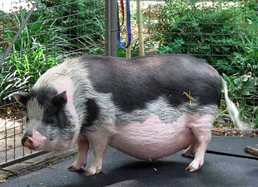
Vietnamese Potbelly Pig
This is most commonly what is seen as pet pigs. (or a cross breed of potbellied pig) Vietnamese Potbelly pigs are a dwarf swine breed which were developed in the 1960's from the breed of Vietnam. Mini pig and potbellied pig have become interchangeable terms in recent years; although that is not the actual name of the breed. They were originally brought into Sweden and Canada and have since moved into a number of countries. Several years ago, when Canadian Keith Connell imported the first potbellied pigs into North America, he had no idea what he had started. Originally, he intended to supply the pigs to zoos, but a private buyer interested in the pigs as pets started the porcine pets trend and they were soon on their way to worldwide distribution and fame.
In 1986, when the first potbellies were sold into the U.S., their market price ran well into the thousands of dollars. As the years went on, and as the breeder market became satisfied, the price of pigs has come down to match that of pedigreed dogs and cats, making them an affordable alternative to canine and feline pets. Breeders who breed for a living will charge substantially more than someone who breeds as a hobby. The problem is regardless of how much you pay, there are no guarantees with regards to size or health. The same pig you pay 2,500.00 for has a sibling looking for a home at a pig rescue. That rescue has likely provided the sibling with much needed medical care and a spay/neuter and will charge an adoption fee that is a small fraction of what someone else paid to purchase the pig from the breeder. Pig rescues and sanctuaries are overflowing with unwanted pet pigs or pigs dumped because of unrealistic size expectations. Pigs can make great pets IF you are ready to provide the suitable environment they need to thrive.
These pigs came to the United States from Canada. The original Canadian pigs averaged 250 lbs. and, therefore, were miniature pigs when compared to domestic swine that weigh 600-1500 lb. Full grown potbellied pigs weigh an average of 70-150 lb. with some reaching 200 lb. or more; they average 3-ft. long and 15-inches tall. Full growth is not reached until about 5 years of age. Colors range from solid black to solid white, with a variety of spots in between.
Potbellied pigs typically have a "potbelly", erect ears and all have hair. This hair falls out once, sometimes twice a year during the annual (or biannual) blowing of the coat. Pigs aren't known for their keen sight, as a matter of fact, pigs do NOT have great vision and because pigs are food motivated animals, often times obesity leads to "fat blindness" and strips them of their ability to see. Arthritis is commonly seen in obese potbellied pigs due to excessive weight. They typically have short legs, snouts can be super short or longer, eyes are wide-set and they have a thick neck (as they age) with a dip in the middle of the back and their hind end is typically rounded. You should NOT be able to see the bone structure but you should be able to easily feel the hip bones with firm pressure. Potbellied pigs are prey animals therefore, easily startled and natural enemies of dogs. Combined with their poor vision, these pigs are often misunderstood as aggressive when they're actually only frightened.
People ask, "Which make better pets, males or females?" We have found that as long as either sex is neutered or spayed, it really doesn't matter. Unspayed females suffer from "PMS" and strong mood swings; intact males produce a pungent odor in addition to displaying other unpleasant traits-neither are desirable pets. Both need to be spayed/neutered to prevent future health complications. A neutered male is called a "barrow," an intact male is a "boar," a female that has never had babies is called a "gilt" and a female that has given birth is a "sow." Most people who purchase these pigs want them as pets, but these pigs do not necessarily stay small, cute, or cuddly. As stated above, their average weight is close to 100 pounds and usually well over that, and they do not like to be picked up or held. While we are well aware there are smaller pigs out there, this is the exception and not the rule. Unlike cats and dogs, pigs are prey not predators, so being lifted up or restrained causes them extreme alarm. Most pigs seen as pets nowadays are a potbelly mix. Mix between other breeds and/or inbreeding. Since the original breeding stock is no longer around, it is difficult to pinpoint a pigs true heritage, so most people use potbelly pigs and "mini pigs" interchangeably; although there are other breeds in the mini pig class of pigs, it is most often used when referring to PBP.
This is most commonly what is seen as pet pigs. (or a cross breed of potbellied pig) Vietnamese Potbelly pigs are a dwarf swine breed which were developed in the 1960's from the breed of Vietnam. Mini pig and potbellied pig have become interchangeable terms in recent years; although that is not the actual name of the breed. They were originally brought into Sweden and Canada and have since moved into a number of countries. Several years ago, when Canadian Keith Connell imported the first potbellied pigs into North America, he had no idea what he had started. Originally, he intended to supply the pigs to zoos, but a private buyer interested in the pigs as pets started the porcine pets trend and they were soon on their way to worldwide distribution and fame.
In 1986, when the first potbellies were sold into the U.S., their market price ran well into the thousands of dollars. As the years went on, and as the breeder market became satisfied, the price of pigs has come down to match that of pedigreed dogs and cats, making them an affordable alternative to canine and feline pets. Breeders who breed for a living will charge substantially more than someone who breeds as a hobby. The problem is regardless of how much you pay, there are no guarantees with regards to size or health. The same pig you pay 2,500.00 for has a sibling looking for a home at a pig rescue. That rescue has likely provided the sibling with much needed medical care and a spay/neuter and will charge an adoption fee that is a small fraction of what someone else paid to purchase the pig from the breeder. Pig rescues and sanctuaries are overflowing with unwanted pet pigs or pigs dumped because of unrealistic size expectations. Pigs can make great pets IF you are ready to provide the suitable environment they need to thrive.
These pigs came to the United States from Canada. The original Canadian pigs averaged 250 lbs. and, therefore, were miniature pigs when compared to domestic swine that weigh 600-1500 lb. Full grown potbellied pigs weigh an average of 70-150 lb. with some reaching 200 lb. or more; they average 3-ft. long and 15-inches tall. Full growth is not reached until about 5 years of age. Colors range from solid black to solid white, with a variety of spots in between.
Potbellied pigs typically have a "potbelly", erect ears and all have hair. This hair falls out once, sometimes twice a year during the annual (or biannual) blowing of the coat. Pigs aren't known for their keen sight, as a matter of fact, pigs do NOT have great vision and because pigs are food motivated animals, often times obesity leads to "fat blindness" and strips them of their ability to see. Arthritis is commonly seen in obese potbellied pigs due to excessive weight. They typically have short legs, snouts can be super short or longer, eyes are wide-set and they have a thick neck (as they age) with a dip in the middle of the back and their hind end is typically rounded. You should NOT be able to see the bone structure but you should be able to easily feel the hip bones with firm pressure. Potbellied pigs are prey animals therefore, easily startled and natural enemies of dogs. Combined with their poor vision, these pigs are often misunderstood as aggressive when they're actually only frightened.
People ask, "Which make better pets, males or females?" We have found that as long as either sex is neutered or spayed, it really doesn't matter. Unspayed females suffer from "PMS" and strong mood swings; intact males produce a pungent odor in addition to displaying other unpleasant traits-neither are desirable pets. Both need to be spayed/neutered to prevent future health complications. A neutered male is called a "barrow," an intact male is a "boar," a female that has never had babies is called a "gilt" and a female that has given birth is a "sow." Most people who purchase these pigs want them as pets, but these pigs do not necessarily stay small, cute, or cuddly. As stated above, their average weight is close to 100 pounds and usually well over that, and they do not like to be picked up or held. While we are well aware there are smaller pigs out there, this is the exception and not the rule. Unlike cats and dogs, pigs are prey not predators, so being lifted up or restrained causes them extreme alarm. Most pigs seen as pets nowadays are a potbelly mix. Mix between other breeds and/or inbreeding. Since the original breeding stock is no longer around, it is difficult to pinpoint a pigs true heritage, so most people use potbelly pigs and "mini pigs" interchangeably; although there are other breeds in the mini pig class of pigs, it is most often used when referring to PBP.
Kune-Kune Pig
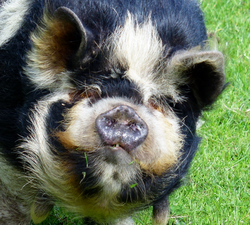 photo courtesy of google search
photo courtesy of google search
KuneKune
The Kunekune pig developed into its present form in New Zealand, although the breed is of Asian origin as indicated by DNA analysis. During most of the period these pigs have been in New Zealand they were kept almost solely by Maori communities, and were to a large extent unknown by Europeans. It is believed they were introduced very early in the European period, probably by whalers or traders, in the early 1800s. A combined excursion in 1984, by Staglands Wildlife Reserve and Willowbank Wildlife Reserve, led to 18 animals being collected; these animals formed the basis of a captive breeding program. Most of the Kunekune pigs found in New Zealand today are descended from that original 18. They are now widely spread throughout New Zealand, with an active society supporting them; in 2004 it was estimated that there were some 5000 animals in the country, both registered and unregistered. Kunekunes have also been exported to the United Kingdom, the United States, and as far as the European continent.
Kunekune pigs are relatively small in comparison to farm type pigs and highly distinctive, characterized physically by a short-legged, dumpy build, pot tummy, short upturned nose, and a generally fat, roundabout appearance. (The Polynesian word ‘kunekune’ simply means ‘plump’.) A unique feature of the kunekune are the pire pire (tassels) hanging from their lower jaw (about 4 cm long). But not all purebreds have tassels. Their legs are short and their bodies are short and round. The color range includes: Black, black and white, white, gold, tan and brown. Temperament-wise they are delightful, being placid, very friendly, and easy to maintain. They thrive on human company, and are extremely popular as pets. Weights for this breed of pigs can exceed 200+ pounds and still be within the healthy range.
Some Kunekunes root the ground in winter. Kunekunes make excellent lawnmowers for your orchard as they do not harm trees and shrubs. It is not recommended that these little pigs be kept in a sty and fattened on grain as they become too fat and are slower to mature. But they do need a small shed or a drum to shelter them from the wet and cold. Losses from pneumonia will occur if this not provided. Initially you may put some hay into their shed but they will soon make their own nest.
Boars become fertile at 6-7 months. Gilts can get pregnant as early as 5 months but it is recommended that they should not be mated that young, giving them time to grow. Infertility is rare but is sometimes caused by boars and sows being too fat. If a male and female are brought up together they may not mate until they have been separated for a couple of weeks and put back together again. Litter numbers vary considerably. The piglets require access to a heat lamp in colder weather for best results.
The Kunekune pig developed into its present form in New Zealand, although the breed is of Asian origin as indicated by DNA analysis. During most of the period these pigs have been in New Zealand they were kept almost solely by Maori communities, and were to a large extent unknown by Europeans. It is believed they were introduced very early in the European period, probably by whalers or traders, in the early 1800s. A combined excursion in 1984, by Staglands Wildlife Reserve and Willowbank Wildlife Reserve, led to 18 animals being collected; these animals formed the basis of a captive breeding program. Most of the Kunekune pigs found in New Zealand today are descended from that original 18. They are now widely spread throughout New Zealand, with an active society supporting them; in 2004 it was estimated that there were some 5000 animals in the country, both registered and unregistered. Kunekunes have also been exported to the United Kingdom, the United States, and as far as the European continent.
Kunekune pigs are relatively small in comparison to farm type pigs and highly distinctive, characterized physically by a short-legged, dumpy build, pot tummy, short upturned nose, and a generally fat, roundabout appearance. (The Polynesian word ‘kunekune’ simply means ‘plump’.) A unique feature of the kunekune are the pire pire (tassels) hanging from their lower jaw (about 4 cm long). But not all purebreds have tassels. Their legs are short and their bodies are short and round. The color range includes: Black, black and white, white, gold, tan and brown. Temperament-wise they are delightful, being placid, very friendly, and easy to maintain. They thrive on human company, and are extremely popular as pets. Weights for this breed of pigs can exceed 200+ pounds and still be within the healthy range.
Some Kunekunes root the ground in winter. Kunekunes make excellent lawnmowers for your orchard as they do not harm trees and shrubs. It is not recommended that these little pigs be kept in a sty and fattened on grain as they become too fat and are slower to mature. But they do need a small shed or a drum to shelter them from the wet and cold. Losses from pneumonia will occur if this not provided. Initially you may put some hay into their shed but they will soon make their own nest.
Boars become fertile at 6-7 months. Gilts can get pregnant as early as 5 months but it is recommended that they should not be mated that young, giving them time to grow. Infertility is rare but is sometimes caused by boars and sows being too fat. If a male and female are brought up together they may not mate until they have been separated for a couple of weeks and put back together again. Litter numbers vary considerably. The piglets require access to a heat lamp in colder weather for best results.
Guinea Hog
 Photo from google search, Cascademeadowsfarm.com
Photo from google search, Cascademeadowsfarm.com
Guinea Hog (African Pygmy)
Guinea hogs, or Guinea Forest hogs, (not really a mini pig, but are often referred to as a "mini" breed~this isn't always the case, guinea hogs can get fairly large naturally. However, using the standard of under 300 pounds-Guinea Hogs would be considered part of the mini pig classification) most likely originated on the Guinea coast of Africa and were spread widely though the slave trade from Africa to England, France, Spain, and America. At one time they were common homestead pigs in the southern U.S., but are now practically unknown. Guinea hogs were also used for breeding with English pigs in the 1700 and 1800's and the very distant relationship between the two types made for an excellent cross.
Historically, Guinea hogs were large and square, with reddish bristly hair, a long tail, and pointed ears. They were hardy grazers and foragers that could be raised on mast and pasture and still produce both lard and pork. Their numbers declined drastically with the collapse of the lard market and the shift away from backyard pork production.
Today's Guinea hogs are small, only 150-300 pounds and 15-20 inches tall when fully grown. They are usually black and often hairy. Guinea hogs are very gentle and easy to care for, making them popular at children's zoos, though, unfortunately, they remain as a choice for small scale pork production. Investigations are continuing into the relationship between modern and historically documented Guinea hogs.
Guinea hogs, or Guinea Forest hogs, (not really a mini pig, but are often referred to as a "mini" breed~this isn't always the case, guinea hogs can get fairly large naturally. However, using the standard of under 300 pounds-Guinea Hogs would be considered part of the mini pig classification) most likely originated on the Guinea coast of Africa and were spread widely though the slave trade from Africa to England, France, Spain, and America. At one time they were common homestead pigs in the southern U.S., but are now practically unknown. Guinea hogs were also used for breeding with English pigs in the 1700 and 1800's and the very distant relationship between the two types made for an excellent cross.
Historically, Guinea hogs were large and square, with reddish bristly hair, a long tail, and pointed ears. They were hardy grazers and foragers that could be raised on mast and pasture and still produce both lard and pork. Their numbers declined drastically with the collapse of the lard market and the shift away from backyard pork production.
Today's Guinea hogs are small, only 150-300 pounds and 15-20 inches tall when fully grown. They are usually black and often hairy. Guinea hogs are very gentle and easy to care for, making them popular at children's zoos, though, unfortunately, they remain as a choice for small scale pork production. Investigations are continuing into the relationship between modern and historically documented Guinea hogs.
Ossabaw Island Pig
 photo courtesy of http://www.scz.org/
Sedgwick county zoo.
photo courtesy of http://www.scz.org/
Sedgwick county zoo.
Ossabaw Island Pig (More of a rare pig and typically not seen as pet pig)
The hogs of Ossabaw Island, off the coast of Georgia, are descendants of Spanish pigs brought to the New World over 400 years ago. They were small range pigs with prick ears, heavy coats and long snouts. Over time, some of the Spanish pigs escaped and became feral in southeastern forests. While most feral pigs eventually mixed with domestic pigs, the Ossabaw Island animals are an exception, having remained a distinct and isolated population. Thus they reflect their Spanish heritage more closely. As the pigs adapted to Ossabaw Island, they became yet smaller, a process called "insular dwarfism." They also had to adapt to the food cycle on the island, which provides little to eat during the spring season. As an adjustment, the Ossabaw Island hogs developed a unique biochemical system of fat metabolism, enabling them to store a larger proportion of fat than any other hog. In conjunction with this, they have a form of low-grade, non-insulin depend diabetes, making them excellent medical research animals. They have been studied for over a decade at the University of Georgia and other institutions.
The unique qualities of the Ossabaw Island hogs do not limit their uses for traditional production. Although in the wild they are smaller than other pigs, with pregnant sows weighting less than 100 pounds, Ossabaws grow much larger in captivity. Colors include black, spotted black and white, red and tan.
It is currently not possible to import animals directly from Ossabaw Island due to quarantine restrictions. Small breeding groups of Ossabaw Island hogs, descendants of animals brought from the island during the 1970's, can be found on the mainland. Offspring of these animals are available from time to time from individual breeders.
The Ossabaw Island hog population is classified as Critical by the American Livestock Breeds Conservancy. The ALBC estimates there are fewer than 200 available in mainland breeding programs, although many more animals can still be found on the island itself. Anyone interested in more information about this breed should contact the American Livestock Breeds Conservancy. I have seen people refer to this breed as one they had in their home, but as you can see, its highly unlikely that is the case. Always a possibility, but still unlikely.
The hogs of Ossabaw Island, off the coast of Georgia, are descendants of Spanish pigs brought to the New World over 400 years ago. They were small range pigs with prick ears, heavy coats and long snouts. Over time, some of the Spanish pigs escaped and became feral in southeastern forests. While most feral pigs eventually mixed with domestic pigs, the Ossabaw Island animals are an exception, having remained a distinct and isolated population. Thus they reflect their Spanish heritage more closely. As the pigs adapted to Ossabaw Island, they became yet smaller, a process called "insular dwarfism." They also had to adapt to the food cycle on the island, which provides little to eat during the spring season. As an adjustment, the Ossabaw Island hogs developed a unique biochemical system of fat metabolism, enabling them to store a larger proportion of fat than any other hog. In conjunction with this, they have a form of low-grade, non-insulin depend diabetes, making them excellent medical research animals. They have been studied for over a decade at the University of Georgia and other institutions.
The unique qualities of the Ossabaw Island hogs do not limit their uses for traditional production. Although in the wild they are smaller than other pigs, with pregnant sows weighting less than 100 pounds, Ossabaws grow much larger in captivity. Colors include black, spotted black and white, red and tan.
It is currently not possible to import animals directly from Ossabaw Island due to quarantine restrictions. Small breeding groups of Ossabaw Island hogs, descendants of animals brought from the island during the 1970's, can be found on the mainland. Offspring of these animals are available from time to time from individual breeders.
The Ossabaw Island hog population is classified as Critical by the American Livestock Breeds Conservancy. The ALBC estimates there are fewer than 200 available in mainland breeding programs, although many more animals can still be found on the island itself. Anyone interested in more information about this breed should contact the American Livestock Breeds Conservancy. I have seen people refer to this breed as one they had in their home, but as you can see, its highly unlikely that is the case. Always a possibility, but still unlikely.
Juliana Pig
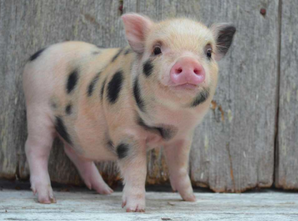 Photo compliments of google search.
Photo compliments of google search.
Juliana Pig (Often a breed you hear about, but only a registry collecting money from people who have pigs that meet their criteria-NOT a recognized breed by scientific standards.)
The Juliana Pig is supposedly a small colorful pig originating in Europe through selective breeding of various kinds of pigs. The Juliana Pig, also known as the Miniature Painted Pig, is small, "always" spotted, and conformationally sound. It should not exhibit a pronounced pot belly or sway back, should have a long snout, and be slight in frame. Temperament is of the utmost importance since the Juliana has been specifically bred to work with humans. While the Juliana breed is quite old it is unsubstantiated as to whether or not the modern Juliana pig is of the same ancestry. The Juliana is a small, colorfully spotted pig. It more closely resembles a small version of a large hog or feral pig then it does the Pot Belly pig. It should be lean, longer then it is tall, and athletic in appearence. The Juliana should never be pudgy, heavily wrinkled, or sluggish in appearance. Please keep in mind, this description is what was found on the "registry" for Juliana pigs. In reality, Juliana pigs are not a breed recognized by the scientific community. " Selective breeding" can certainly account for the required spots in order for a pig to be included in the registry (that was created by the people breeding these pigs, who can charge premium prices for "rare" spotted pigs), but, that alone, does not make it a breed. See our take on registering pigs above.
Lean and musculular the Juliana pig should never look round or flabby. The top line should be straight and of good length. Chest and shoulders should be of medium width, neither broad nor narrow. A slight sway in the back may be seen. Belly should be lean and firm. A slight roundness in the belly is possible, but there should not be a "Potbelly" present.
Always spotted the base color can be silver, white, red, rust, black, or cream. Spots are generally black but can also be red or white. Spotting should be profuse and random, not in a piebald pattern. Spotting may fade or blend in as the hair coat gets longer, but pigmentaion on the skin must be visible when washed or shaved. Hair coat is coarse, thick and may be quite long in the winter.
This is a classic example of breeders creating a registry in order to make a breed look as if it exists. Just because there is a registry doesn't mean a breed exists. Period. http://www.thoughtiboughtateacupbutgotafatpigregistry.org
The Juliana Pig is supposedly a small colorful pig originating in Europe through selective breeding of various kinds of pigs. The Juliana Pig, also known as the Miniature Painted Pig, is small, "always" spotted, and conformationally sound. It should not exhibit a pronounced pot belly or sway back, should have a long snout, and be slight in frame. Temperament is of the utmost importance since the Juliana has been specifically bred to work with humans. While the Juliana breed is quite old it is unsubstantiated as to whether or not the modern Juliana pig is of the same ancestry. The Juliana is a small, colorfully spotted pig. It more closely resembles a small version of a large hog or feral pig then it does the Pot Belly pig. It should be lean, longer then it is tall, and athletic in appearence. The Juliana should never be pudgy, heavily wrinkled, or sluggish in appearance. Please keep in mind, this description is what was found on the "registry" for Juliana pigs. In reality, Juliana pigs are not a breed recognized by the scientific community. " Selective breeding" can certainly account for the required spots in order for a pig to be included in the registry (that was created by the people breeding these pigs, who can charge premium prices for "rare" spotted pigs), but, that alone, does not make it a breed. See our take on registering pigs above.
Lean and musculular the Juliana pig should never look round or flabby. The top line should be straight and of good length. Chest and shoulders should be of medium width, neither broad nor narrow. A slight sway in the back may be seen. Belly should be lean and firm. A slight roundness in the belly is possible, but there should not be a "Potbelly" present.
Always spotted the base color can be silver, white, red, rust, black, or cream. Spots are generally black but can also be red or white. Spotting should be profuse and random, not in a piebald pattern. Spotting may fade or blend in as the hair coat gets longer, but pigmentaion on the skin must be visible when washed or shaved. Hair coat is coarse, thick and may be quite long in the winter.
This is a classic example of breeders creating a registry in order to make a breed look as if it exists. Just because there is a registry doesn't mean a breed exists. Period. http://www.thoughtiboughtateacupbutgotafatpigregistry.org
Meishan Pig
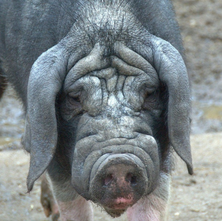 Photo courtesy of google image search
Photo courtesy of google image search
Meishan Pigs
The Meishan breed was introduced into the United States under a cooperative effort of the USDA, the University of Illinois, and Iowa State University. This effort also imported Fengjing and Minzhu pigs from China. A total of 144 pigs from these breeds were shipped to the United States. Iowa State University received 22 Meishan females and 10 Meishan boars from this shipment on July 27, 1989. More recently, Meishan pigs have reached households and are available to the general public. These pigs are NOT considered "mini" pigs, but because of inaccurate information, people think these pigs will stay on the smaller side. This is not the case.
Meishan pigs come from the region of lakes and valleys in China. They are considered Taihu pigs, deriving their name from the Taihu Lake in their region of origin. This region lies in the Mid Subtropic Belt, a narrow region between North and Central China, in the Lower Changjiang River Basin and Southeast Coast. This area has a mild climate.
The breeds imported from China are slow growing and fat. They are considered to be resistant to some diseases and are able to consume large amounts of roughage. Meishan pigs are well fed and managed, being fed farm by-products and water plants, as well as concentrates.
The Meishan breed is known for its wrinkled face and skin. Sows grow to be about 57.8 cm high, 100 cm around the chest, and 61.6 kg in live-weight. They have a backfat thickness of 2.5 cm and a dressing percentage of 66.8%. Meishan pigs are perhaps one of the most prolific breeds of pig in the world. They reach puberty at 2.5-3 months of age, achieve high embryo survival rates, and a large litter size of 15-16 pigs. It is quite common to have two litters per year. Third and later parities of this breed had 17.0 pigs born, with 12.9 being weaned. Their 240 day weight was 170.5 lbs., with an ADG of 0.75 lbs.
The Meishan breed was introduced into the United States under a cooperative effort of the USDA, the University of Illinois, and Iowa State University. This effort also imported Fengjing and Minzhu pigs from China. A total of 144 pigs from these breeds were shipped to the United States. Iowa State University received 22 Meishan females and 10 Meishan boars from this shipment on July 27, 1989. More recently, Meishan pigs have reached households and are available to the general public. These pigs are NOT considered "mini" pigs, but because of inaccurate information, people think these pigs will stay on the smaller side. This is not the case.
Meishan pigs come from the region of lakes and valleys in China. They are considered Taihu pigs, deriving their name from the Taihu Lake in their region of origin. This region lies in the Mid Subtropic Belt, a narrow region between North and Central China, in the Lower Changjiang River Basin and Southeast Coast. This area has a mild climate.
The breeds imported from China are slow growing and fat. They are considered to be resistant to some diseases and are able to consume large amounts of roughage. Meishan pigs are well fed and managed, being fed farm by-products and water plants, as well as concentrates.
The Meishan breed is known for its wrinkled face and skin. Sows grow to be about 57.8 cm high, 100 cm around the chest, and 61.6 kg in live-weight. They have a backfat thickness of 2.5 cm and a dressing percentage of 66.8%. Meishan pigs are perhaps one of the most prolific breeds of pig in the world. They reach puberty at 2.5-3 months of age, achieve high embryo survival rates, and a large litter size of 15-16 pigs. It is quite common to have two litters per year. Third and later parities of this breed had 17.0 pigs born, with 12.9 being weaned. Their 240 day weight was 170.5 lbs., with an ADG of 0.75 lbs.
Mulefoot Pig
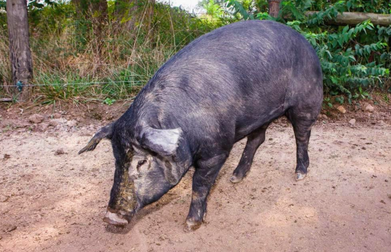
Mulefoot
The most distinctive feature of the American Mulefoot hog is the solid hoof which resembles that of a mule. Pigs with solid hooves (also called syndactylism) have attracted the interest of many writers over the centuries, including Aristotle and Darwin. Yet of all the mulefooted hogs described, the American Mulefoot is the only documented population with a breed standard and a long history of agricultural use. The breed is actually a genetic defect though. These pigs sometimes suffer horribly with pain associated with walking because of being bred for this "desired" trait.
This breed is unique to the United States and is critically rare according to the Mulefoot organization. Recent events, however, have led to more optimism regarding its' survival.The origin of the American Mulefoot breed is not clear, but it has a well-documented history over the last century. F.D. Coburn, in his classic 1916 book 'Swine in America', notes that the Mulefoot hog was found in Arkansas, Missouri, Iowa, Indiana, across the southwest and in some parts of Mexico. (In southern Missouri and northern Arkansas, Mulefoots were sometimes called "Ozark pigs.") The National Mulefoot Hog Record Association was organized in Indianapolis, Indiana, in January 1908. Two additional registries were also founded. In 1910 there were 235 breeders registered in twenty-two states. Syndactyly is considered a birth defect in pigs.
Coburn describes Mulefoot hogs as mainly black, with occasional animals having white points; medium flop ears; and a soft hair coat. The hogs were of fairly gentle disposition, fattened quite easily, and weighed from 400-600 pounds at two years of age. For some years breeders claimed that Mulefoots were immune to hog cholera. That claim has been disproved, though the breed does seem to posses remarkable hardiness. Mulefoots were taken to Canada between 1900 and 1920 but no attempt was made to establish a herd book and pedigree records were not maintained according to J. W. MacEwan in The Breeds of Farm Livestock in Canada, 1941.
Today, the Mulefoot is the rarest of American swine breeds. It has been a conservation priority for American Livestock Breeds Conservancy for over a decade. A very thick file of correspondence attests to continued attempts to locate and evaluate additional populations and establish new breeding groups.
A remnant population of the American Mulefoot has been owned by R.M. Holliday of Louisiana, Missouri, for nearly forty years. He remembers from boyhood that his family and others raised these hogs by putting them on islands in the Missouri and Mississippi Rivers to forage during the summer and then rounding them up in the fall for slaughter. This practice was terminated by the Army Corps of Engineers in the 1950s.
The most distinctive feature of the American Mulefoot hog is the solid hoof which resembles that of a mule. Pigs with solid hooves (also called syndactylism) have attracted the interest of many writers over the centuries, including Aristotle and Darwin. Yet of all the mulefooted hogs described, the American Mulefoot is the only documented population with a breed standard and a long history of agricultural use. The breed is actually a genetic defect though. These pigs sometimes suffer horribly with pain associated with walking because of being bred for this "desired" trait.
This breed is unique to the United States and is critically rare according to the Mulefoot organization. Recent events, however, have led to more optimism regarding its' survival.The origin of the American Mulefoot breed is not clear, but it has a well-documented history over the last century. F.D. Coburn, in his classic 1916 book 'Swine in America', notes that the Mulefoot hog was found in Arkansas, Missouri, Iowa, Indiana, across the southwest and in some parts of Mexico. (In southern Missouri and northern Arkansas, Mulefoots were sometimes called "Ozark pigs.") The National Mulefoot Hog Record Association was organized in Indianapolis, Indiana, in January 1908. Two additional registries were also founded. In 1910 there were 235 breeders registered in twenty-two states. Syndactyly is considered a birth defect in pigs.
Coburn describes Mulefoot hogs as mainly black, with occasional animals having white points; medium flop ears; and a soft hair coat. The hogs were of fairly gentle disposition, fattened quite easily, and weighed from 400-600 pounds at two years of age. For some years breeders claimed that Mulefoots were immune to hog cholera. That claim has been disproved, though the breed does seem to posses remarkable hardiness. Mulefoots were taken to Canada between 1900 and 1920 but no attempt was made to establish a herd book and pedigree records were not maintained according to J. W. MacEwan in The Breeds of Farm Livestock in Canada, 1941.
Today, the Mulefoot is the rarest of American swine breeds. It has been a conservation priority for American Livestock Breeds Conservancy for over a decade. A very thick file of correspondence attests to continued attempts to locate and evaluate additional populations and establish new breeding groups.
A remnant population of the American Mulefoot has been owned by R.M. Holliday of Louisiana, Missouri, for nearly forty years. He remembers from boyhood that his family and others raised these hogs by putting them on islands in the Missouri and Mississippi Rivers to forage during the summer and then rounding them up in the fall for slaughter. This practice was terminated by the Army Corps of Engineers in the 1950s.
Yucatan Pig
Feral Pig
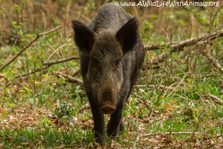
(Photos in feral pig slide show compliments of google search)
Feral pigs/Wild pigs
The information below is based on adult "wild" boars. Some of these are maximum stats and not a reflection of the average size which is much smaller:
Scientific name - Sus scrofa
Life Span: 10 - 15 years
Weight - Adult Female: 80 - 120kg
Weight - Adult Male: 100 - 175kg
Wild boar had been spotted all across the US as well as other areas of the world, and they are unusual in that many of them are active in the daytime (diurnal), some of the boar that others have come across also dispel the myth that all boar are scared of humans, there is an increasing number that are happy to casually trundle up to people, often in search of food. There are people who have feral pigs as pets and have been able to train them much like more domesticated pigs to act as a pet. Both female and male feral pigs have tusks (as do every other breed), although they usually only protrude from the mouth in older animals. Feral/feral mixes are often advertised as "chipmunk" or striped pigs.
Wild boars have a reputation for not liking and in some cases attacking and killing domestic dogs. This is true, but I challenge you to name one species of wildlife, which does like dogs. Wild boars have the ability and are more than capable of standing up to a possible threat; after all they live alongside large predators such as the lion and tiger in countries such as Africa and India. Before they were eradicated in Britain during the 13th century, they were predated by another native, yet now extinct species; the wolf! When they look at our dogs, they do not see a dog, they see a wolf and it is a deep born reaction to stand and fight as a wild boar will never outrun a pack of wolves! They have extremely strong jaws to crack open hard-shelled nuts such as hickory nuts and pecans. As they predate upon or scavenge animal carcasses, they can easily break bones and often consume the entire carcass, often leaving little if any sign behind. Wild pigs are opportunistic omnivores, meaning they feed on plant and animal matter in addition to being able to play the role of a scavenger. They are largely indiscriminant in their feeding habits and eat both vertebrate and invertebrate animals. Approximately 85% to 90% of their diet is believed to be composed of vegetation (including crops where available) and 10% animal matter. Small pigs may eat approximately 5% of their body weight daily; larger pigs an estimated 3 % of body weight.
The main differences we usually see are the longer, narrower snout and longer leaner bodies. The coloring can also be "chipmunk" or striped colors, however, this color usually fades away leaving a solid brownish color in its place after several months. As beautiful as they are, these are not pigs you would want to reach out and pet. These pigs are wild and therefore need to be respected in their environment.
Some states have a real problem with feral pigs causing massive destruction and allow hunting of feral pigs at any time. Pigs were first introduced in the 1500’s to what is now the southeastern U.S. by Spanish Explorer, Hernando DeSoto. In the centuries following European exploration and colonization of the eastern U.S., free-range livestock management practices and escapes from enclosures resulted in the establishment of wild pig populations and promoted their spread.
Coping with feral hogs
According to Texas A&M:
Feral hogs (or Wild Hogs) continue to grow in numbers in Texas and elsewhere. Because of their destructive feeding habits and potential to spread disease, feral hogs are a substantial liability to agriculture and native wildlife in Texas. However, these animals are also sought for recreational hunting and commercial harvest. The resources provided here are intended to increase the understanding of feral hog biology, natural history, damage management, and control techniques.
Do NOT approach a feral pig and expect this pig to act in the same manner as a pet pig would act. You can get seriously injured or even killed by a feral pig. Not all of them are bad, but you don't know which ones are and aren't. This also brings a concern of the possibility of bringing disease home to your current pig. (Some of the more contagious diseases/illnesses can be carried in from the soles of your shoes) Here is a video of a Japanese reporter being attacked by a wild boar. http://www.dailymail.co.uk/news/A-really-wild-boar-left-tv-reporter-on-crutches-attacked-streets-Japan.
Feral pigs/Wild pigs
The information below is based on adult "wild" boars. Some of these are maximum stats and not a reflection of the average size which is much smaller:
Scientific name - Sus scrofa
Life Span: 10 - 15 years
Weight - Adult Female: 80 - 120kg
Weight - Adult Male: 100 - 175kg
Wild boar had been spotted all across the US as well as other areas of the world, and they are unusual in that many of them are active in the daytime (diurnal), some of the boar that others have come across also dispel the myth that all boar are scared of humans, there is an increasing number that are happy to casually trundle up to people, often in search of food. There are people who have feral pigs as pets and have been able to train them much like more domesticated pigs to act as a pet. Both female and male feral pigs have tusks (as do every other breed), although they usually only protrude from the mouth in older animals. Feral/feral mixes are often advertised as "chipmunk" or striped pigs.
Wild boars have a reputation for not liking and in some cases attacking and killing domestic dogs. This is true, but I challenge you to name one species of wildlife, which does like dogs. Wild boars have the ability and are more than capable of standing up to a possible threat; after all they live alongside large predators such as the lion and tiger in countries such as Africa and India. Before they were eradicated in Britain during the 13th century, they were predated by another native, yet now extinct species; the wolf! When they look at our dogs, they do not see a dog, they see a wolf and it is a deep born reaction to stand and fight as a wild boar will never outrun a pack of wolves! They have extremely strong jaws to crack open hard-shelled nuts such as hickory nuts and pecans. As they predate upon or scavenge animal carcasses, they can easily break bones and often consume the entire carcass, often leaving little if any sign behind. Wild pigs are opportunistic omnivores, meaning they feed on plant and animal matter in addition to being able to play the role of a scavenger. They are largely indiscriminant in their feeding habits and eat both vertebrate and invertebrate animals. Approximately 85% to 90% of their diet is believed to be composed of vegetation (including crops where available) and 10% animal matter. Small pigs may eat approximately 5% of their body weight daily; larger pigs an estimated 3 % of body weight.
The main differences we usually see are the longer, narrower snout and longer leaner bodies. The coloring can also be "chipmunk" or striped colors, however, this color usually fades away leaving a solid brownish color in its place after several months. As beautiful as they are, these are not pigs you would want to reach out and pet. These pigs are wild and therefore need to be respected in their environment.
Some states have a real problem with feral pigs causing massive destruction and allow hunting of feral pigs at any time. Pigs were first introduced in the 1500’s to what is now the southeastern U.S. by Spanish Explorer, Hernando DeSoto. In the centuries following European exploration and colonization of the eastern U.S., free-range livestock management practices and escapes from enclosures resulted in the establishment of wild pig populations and promoted their spread.
Coping with feral hogs
According to Texas A&M:
Feral hogs (or Wild Hogs) continue to grow in numbers in Texas and elsewhere. Because of their destructive feeding habits and potential to spread disease, feral hogs are a substantial liability to agriculture and native wildlife in Texas. However, these animals are also sought for recreational hunting and commercial harvest. The resources provided here are intended to increase the understanding of feral hog biology, natural history, damage management, and control techniques.
Do NOT approach a feral pig and expect this pig to act in the same manner as a pet pig would act. You can get seriously injured or even killed by a feral pig. Not all of them are bad, but you don't know which ones are and aren't. This also brings a concern of the possibility of bringing disease home to your current pig. (Some of the more contagious diseases/illnesses can be carried in from the soles of your shoes) Here is a video of a Japanese reporter being attacked by a wild boar. http://www.dailymail.co.uk/news/A-really-wild-boar-left-tv-reporter-on-crutches-attacked-streets-Japan.
The government also has a link regarding the care for feral pigs. http://www.invasivespeciesinfo.gov/animals/wildboar.shtml
In most states, it is illegal to keep a feral pig as a domesticated pet. Feral pigs are known carriers of pseudorabies (click here to read more about pseudorabies) and because they can sometimes come in contact with our pet pigs, this is something that can be concerning to those who live in areas with a high feral population.
In most states, it is illegal to keep a feral pig as a domesticated pet. Feral pigs are known carriers of pseudorabies (click here to read more about pseudorabies) and because they can sometimes come in contact with our pet pigs, this is something that can be concerning to those who live in areas with a high feral population.
Sources for the above information: There are many other pig breeds not discussed here because they're not commonly seen or marketed as pet pigs. Feel free to click on the links below to research other pig breeds. Please keep in mind, a registry is something breeders establish and set the standards for, so just because there is a registry, that doesn't mean that there is an actual scientifically recognized breed.
http://www.thepigsite.com/forums/Meishans
http://www.ansi.okstate.edu/breeds/swine/
http://www.julianapig.com
http://americankunekunepigsociety.com
http://scampp.com/Breeds/Types
http://mulefootpigs.tripod.com
http://www.awlwa.org/wild-boar
http://wildpiginfo.msstate.edu/history-wild-pigs
http://feralhogs.tamu.edu
http://www.thepigsite.com/forums/Meishans
http://www.ansi.okstate.edu/breeds/swine/
http://www.julianapig.com
http://americankunekunepigsociety.com
http://scampp.com/Breeds/Types
http://mulefootpigs.tripod.com
http://www.awlwa.org/wild-boar
http://wildpiginfo.msstate.edu/history-wild-pigs
http://feralhogs.tamu.edu
A ban in legislation in Michigan affects a lot more than feral pigs.
http://www.infowars.com/confirmed-michigan-pig-ban-will-eliminate-all-heritage-breeds-destroy-thousands-of-small-scale-farms/
http://www.infowars.com/confirmed-michigan-pig-ban-will-eliminate-all-heritage-breeds-destroy-thousands-of-small-scale-farms/
Babies with their mothers
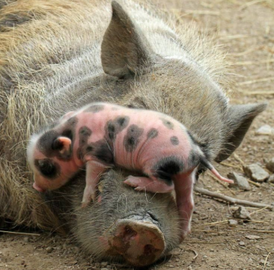
This is when it can get confusing to a lot of people. they see a super small baby pig and are told these piglets won't grow much bigger. Not only is this not true, but it's setting up families for big disappointments. Do not buy into that "teacup, micro mini pig" myth. ALL pigs grow bigger. Different angles may make it appear as if mama pig or piglets are smaller than what they really are. People will take flattering pictures of the piglets to entice you to purchase from them. Some of these pictures will show pigs that are only hours old. The difference in their size will vary greatly from the time they were born until they're 6 weeks, which is the least recommended age when they should be taken from their mother. The preferred age is more around 8-12 weeks, if possible. Remember, they learn manners and respect from their mother and siblings, so it isn't just about their health, it's about their long term well-being and future behavior as well. Click here to read more about underaged piglets and the dangers of caring for them.
How do I know I am getting the "smaller" version of a pig?
How to spot the differences in a farm pig and a "mini" pig
A farm pig has specific characteristics that set them apart from mini pigs. A mini pig is a subclass of pigs that are smaller than the farm pig. Potbellied pigs and mini pigs are terms typically used interchangeably, they have smaller, more erect ears. They usually have a little sway to their back, and shorter legs than the production pigs, and they have a straight tail that loves to wag when they’re happy. Because so many breeds fall into the "mini" category, body shape can differ. For example, Juliana breed pigs typically don't have the "potbelly" that potbellied pigs are known to have. KuneKunes have the wattle that other breeds aren't known for, Meshian pigs have the wrinkly skin and a different look altogether than mini pig breeds. ALL the piglets are small when born, but they all grow much bigger. Some people classify larger breed pigs as "mini" pigs, so the term mini is used loosely and can be misleading all by itself. Mini pigs are usually anything BUT mini.
Farm Pigs typically have "floppy" ears and a curly tail and sometimes a longer snout. They're known to have longer legs and leaner bodies, as piglets, they can certainly be mistaken for a mini pig if you're not educated on mini pig breeds. There are multiple breeds of "full size" farm/production pigs as well and they come in all shapes, colors and sizes too. Pigs are pigs, there has been so much cross breeding that it is sometimes difficult to tell. Following this are some piglet pictures both of farm pigs and "mini" pigs. Images courtesy of Google.
Farm Pigs typically have "floppy" ears and a curly tail and sometimes a longer snout. They're known to have longer legs and leaner bodies, as piglets, they can certainly be mistaken for a mini pig if you're not educated on mini pig breeds. There are multiple breeds of "full size" farm/production pigs as well and they come in all shapes, colors and sizes too. Pigs are pigs, there has been so much cross breeding that it is sometimes difficult to tell. Following this are some piglet pictures both of farm pigs and "mini" pigs. Images courtesy of Google.
Farm Hog Piglets
These are full sized piglets. these pigs grow much bigger than the "mini" pig breeds do. Keep in mind, sometimes it's difficult to tell what type of pig you are looking at, especially if you are new to pigs. You can see the leaner body structure, longer legs as well as the bigger ears and longer snout in the farm type pig breeds normally. They typically have a "stocky" type of appearance compared to a mini pig breed.
Mini Piglets
These are more than likely the type of pictures you may see when you are looking for a piglet. Posed for a photoshoot, cute and always small. Keep in mind, many of these pictures are taken when piglets are only hours or maybe days old. Ask for updated pictures to see how much a piglet has grown in a month's period of time, ask for pictures to be sent to you frequently. Ears are normally erect in most mini breeds. The body can be pudgy, sometimes with a small "potbelly". The legs are normally shorter and the snout is usually shorter with a slightly smushed look. These are the same traits found in potbellied pigs.
Miniature Pig and farm pig comparison
Ear shape of both "mini" and full sized pigs
Information collected and written by Brittany Sawyer & Dawn Camp

